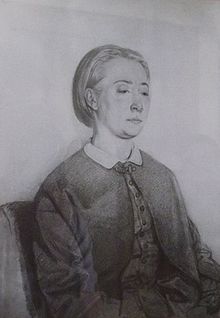Helena Skirmunt
Helena Skirmunt ( Russian Хелена Скирмунт ; born October 24, jul. / 5. November 1827 greg. On the estate Kolodno, Stolin District , † January 20 jul. / 1. February 1874 greg. In Amélie-les-Bains-Palalda ) was a Russian painter and sculptor .
Life
Helena Skirmunt came from the Polish-Lithuanian noble family Skirmunt. Her father was the landlord and marshal of the powiat Pinsk Alexander Skirmunt. Her mother Hortensija nee Orda was the sister of the painter Napoleon Orda , who influenced his niece very much. Helena Skirmunt learned painting with Wincenty Dmochowski in Wilna . At the age of 18, she accompanied her future mother-in-law Konstanzija Skirmunt on a trip to Western Europe . She studied with Wilhelm Krause in Berlin and Carl Christian Vogel von Vogelstein in Dresden .
Skirmunt married the landlord and architect Kasimir Skirmunt (uncle of the Belarusian politician Roman Skirmunt and great-uncle of the Polish politician Konstanty Skirmunt ) in 1848 , with whom she settled on the Kolodno estate and had four children. She took care of the farmers and taught Polish in the village schools. In 1852 she traveled to Vienna for an eye treatment . She studied with Josef Cesar and then traveled to Italy . She visited Milan , Florence , Rome and Naples . She studied with Pietro Galli and L. Amici. After her return, she created Bas-Relief medallions with portraits of relatives, friends and well-known people ( Bronisław Zaleski (1859), Joachim Lelewel (1860), Józef Ignacy Kraszewski ).
Skirmunt was in contact with her husband in the Polish uprising of 1863 , and there was an episode with the leader General Romuald Traugutt . She was then exiled to Tambov , while her husband was exiled to Kostroma and eventually came to Tambov. In 1867 they were allowed to return to their native Polesia . After a few months, her husband was again exiled to Balaklava in the Crimea . In 1869 she was exiled to Balaklava herself.
In 1872 Skirmunt's health deteriorated. She contracted diphtheria and traveled to Western Europe for treatment. She died in Amélie-les-Bains-Palalda in 1874. In 1875 her ashes were allowed to be transferred to Pinsk and buried there.
Works
Cathedral of the Assumption in Pinsk (1861)
Church of St. Charles Borromeo in Pinsk (1868)
Web links
- Literature by and about Helena Skirmunt in the bibliographic database WorldCat
Individual evidence
- ↑ Oxford Index: Skirmunt, Helena (accessed January 25, 2020).
- ↑ Women's database fembio.o: Helena Skirmunt (accessed January 25, 2020).
- ↑ a b c d e Chartyja '97: Непокорная литвинка (accessed January 25, 2020).
- ^ A b c d e f Гелена Скирмунт: литвинка, патриотка, первая женщина-скульптор . In: Komsomolskaya Pravda . May 31, 2017 ( [1] [accessed January 25, 2020]).
| personal data | |
|---|---|
| SURNAME | Skirmunt, Helena |
| ALTERNATIVE NAMES | Скирмунт, Хелена (Russian) |
| BRIEF DESCRIPTION | Russian painter and sculptor |
| DATE OF BIRTH | November 5, 1827 |
| PLACE OF BIRTH | Kolodno, Stolin district |
| DATE OF DEATH | February 1, 1874 |
| Place of death | Amélie-les-Bains-Palalda |






